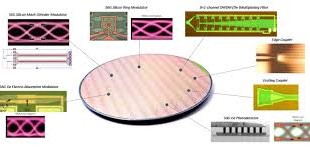Introduction
In the era of digital connectivity and information sharing, the security of our data has never been more critical. With increasing concerns about privacy breaches and cyberattacks, it’s essential to explore innovative solutions to safeguard our digital interactions. Quantum Key Distribution (QKD) is emerging as a game-changer in the realm of secure communication, and when combined with Silicon-photonics-based chips, it has the potential to transform smartphone security. In this article, we will explore how smartphones equipped with Quantum Cryptography are revolutionizing mobile security, offering unprecedented protection against evolving threats.
Smartphones are ubiquitous devices that store and process a vast amount of sensitive data, from personal information to financial transactions. This makes them a prime target for cyberattacks. Traditional security measures, such as encryption and passwords, are becoming increasingly vulnerable as computing power increases.
The Quantum Advantage
Quantum Cryptography leverages the quirky and counterintuitive nature of quantum mechanics to secure data. The process involves transmitting quantum bits or qubits between two parties, typically called Alice and Bob. Any attempt to intercept these qubits, as often done by hackers in classical encryption, is inherently detected, making it virtually impossible for eavesdroppers to access the information. This level of security is unmatched by classical encryption methods.
Unhackable Mobile Security
Quantum Key Distribution (QKD) technology can significantly enhance smartphone security in several ways. It can be employed to secure wireless communication between smartphones and other devices, including servers and base stations, effectively safeguarding sensitive information like financial transactions and personal data from potential interception by malicious actors. QKD’s application extends to securing data storage on smartphones by encrypting it, rendering the information inaccessible even if the device is stolen or compromised. Furthermore, QKD can be utilized for device authentication, preventing attackers from impersonating legitimate devices, thereby enhancing overall security and safeguarding sensitive data from unauthorized access.
The combination of Quantum Cryptography and Silicon Photonics offers several advantages:
- Two-Factor Authentication: Smartphones equipped with quantum security offer two-factor authentication powered by Quantum Random Number Generators (QRNG). This makes services such as mobile payments, biometric authentication, and secure document storage more robust and resistant to hacking.
- Unbreakable Encryption: Quantum-secure smartphones ensure that encrypted data remains confidential. Even with advances in quantum computing, this encryption is nearly impossible to break.
- Widespread Adoption: As quantum-secure technology becomes more accessible, its application extends to a variety of services, from online marketplaces to navigation apps. This ensures that a broad user base can benefit from enhanced security.
Protection from Quantum Attacks:
As quantum computers advance, they pose a threat to classical encryption methods. QKD offers defense against these quantum attacks, making it future-proof.
Post-quantum cryptography endeavors to modernize existing cryptographic algorithms and standards, ensuring that current infrastructures remain resilient in a post-quantum digital world. However, it’s important to note that this approach, while necessary, still retains a security profile founded on multiple unproven assumptions. On the other hand, quantum cryptography stands out by offering an exceptionally robust security guarantee rooted solely in the fundamental laws of quantum physics, making it, in principle, invulnerable to attacks.
In this context, quantum cryptography is increasingly recognized as the safer pathway, particularly for critical information infrastructures with long-term security requirements, such as healthcare, government operations, and banking. Quantum Key Distribution (QKD) systems are under active development in several countries, including Austria, Canada, China, Japan, South Korea, Switzerland, the United States, and the United Kingdom. Despite the potential of quantum cryptography, the current methods and processes required to enable these quantum technologies are often constrained and prohibitively expensive, rendering quantum cryptography less appealing for widespread deployment.
Silicon Photonics: The Game Changer
Although commercially viable QKD transmitters and receivers do exist, they tend to be bulky and costly, making them suitable primarily for high-value security applications. The industry’s aspiration is to overcome these size, weight, and power (SWaP) constraints, striving to offer practical quantum-secured communications that can serve broader markets, encompassing consumers, commerce, and governmental institutions. Additionally, ongoing research is rapidly advancing alternative methods for implementing QKD, such as encoding information into the phase of multiphoton pulses and systems based on entangled photons, further propelling the development and accessibility of quantum-secure communication technologies.
Silicon-photonics-based chips are miniaturized optical devices that can be used to implement QKD systems. These chips are small, lightweight, and energy-efficient, making them ideal for integration into smartphones.
The integration of Quantum Key Distribution (QKD) into smartphones is made possible through Silicon Photonics, a cutting-edge technology. Silicon-photonics-based chips are engineered to generate, manipulate, and detect individual photons used in the quantum key exchange process. These chips are compact, energy-efficient, and seamlessly integrated into smartphone hardware. They have the potential to bring quantum security to a wide audience.
Challenges of QKD chips on Mobiles
The challenges of integrating Quantum Key Distribution (QKD) chips into mobile devices are a prominent concern in the field of quantum cryptography. Currently, the most practical and commercially advanced QKD systems rely on the use of single photons generated by attenuating laser pulses. These systems were initially developed as large modules that fit into 19-inch racks. However, more recent advancements have led to the creation of chip-scale prototypes with significantly reduced size, weight, and power consumption (SWaP). These compact prototypes hold the potential for seamless integration into consumer electronics.
Photonics technology stands out as a breakthrough for miniaturizing QKD systems. Photonics, using photons as the data carriers, offers a viable alternative to traditional electronic Integrated Circuits (ICs) that use electrons. Photonics leverages the incredible speed of light, making it ideal for transferring vast amounts of data at high speeds, primarily within the domains of optical fiber and optical free space communications.
Furthermore, the development of Photonic Integrated Circuits (PICs) or Integrated Photonic Circuits (IPCs) is a key advancement in SWaP-saving initiatives. PICs combine multiple photonic functions on a single chip, often encompassing elements like single photon sources, nonlinear photon processing circuits, and photon detectors. These circuits are highly regarded for their small footprint, scalability, reduced power consumption, and enhanced processing stability.
The ultimate objective is to engineer QKD on cost-effective chips that can be seamlessly integrated into smartphones and other consumer devices. While the physics underpinning this technology is well-established, the primary challenge revolves around achieving the necessary miniaturization. Chip-scale photon sources have shown promise by using light sources with filters to control the production of single photons, catering to current commercial QKD requirements. However, additional challenges remain in the photonics domain, particularly concerning the development of chip-scale entangled photon sources for alternative approaches to QKD. Furthermore, the development of compact detectors poses a more complex challenge, as materials sensitive enough to detect single photons are typically bulky. The best detector materials currently available are superconducting but require substantial cooling apparatus. Nevertheless, while early QKD implementations might involve secure end-user locations like banks or government departments that can accommodate bulkier detectors, the long-term objective is to create smaller, more practical detectors, enabling devices such as laptops to communicate directly with each other. This points toward the future integration of semiconductor devices within the realm of quantum cryptography.
Widespread Adoption
As quantum-secure technology becomes more accessible, its application extends to a variety of services, from online marketplaces to navigation apps. This ensures that a broad user base can benefit from enhanced security.
- Secure Digital Transactions: With QKD-enabled smartphones, digital transactions become safer than ever. Whether it’s mobile banking, online shopping, or sharing sensitive files, your data is protected.
- Government and Enterprise Use: Beyond individual users, governments and businesses can benefit immensely from QKD-enabled smartphones, ensuring confidential communications and data protection.
Recent Advancements
Researchers at the University of Bristol have achieved a significant breakthrough in quantum key distribution (QKD) technology with chip-based devices that house all the optical components necessary for QKD on compact chips measuring just 6 × 2 mm. These mass-manufacturable, monolithically integrated transmitters demonstrated secure quantum key exchange over fiber networks spanning up to 200 km. The chips rely on semiconductor technology similar to that used in smartphones and computers, allowing for a substantial reduction in size and power consumption while maintaining high-speed performance. By streamlining connections between users through a centralized node, the platform provides the infrastructure needed for the development of citywide quantum networks, all while ensuring secure and efficient communication. These chip-based devices offer precise control and complexity, making them an ideal foundation for the future of quantum networks.
Imec and the National University of Singapore (NUS) have embarked on a joint research collaboration aimed at advancing chip-based quantum cryptography technology.
This five-year agreement seeks to develop chip-based prototypes for secure quantum communication networks. Imec and NUS will combine their theoretical, experimental, and engineering expertise to address existing bottlenecks and enhance the scalability, robustness, and cost-effectiveness of Quantum Key Distribution (QKD) and Quantum Random Number Generation (QRNG) technologies.
The initial focus will be on developing an ultrafast QRNG chip, crucial for generating secret keys, followed by the creation of a compact, fully-integrated photonic quantum transmitter prototype chip. Imec’s deep knowledge in silicon photonics technology, initially developed for conventional data communication and telecom applications, will play a pivotal role in this endeavor. NUS will contribute expertise in theory, protocol design, and proof-of-concept experiments, aiming to translate these solutions into real silicon-photonics-based chips.
Smartphone featuring QKD
Samsung:
Samsung has been developing QKD technology for several years and has released a prototype QKD-enabled smartphone in 2022.
In May 2020, Samsung and SK Telecom introduced the world’s first 5G smartphone featuring a Quantum Random Number Generator (QRNG) called the Galaxy A Quantum, essentially a rebranded Galaxy A71 5G. The QRNG technology employs an LED and CMOS image sensor, fitting into a compact 2.5mm by 2.5mm chip. It utilizes quantum noise to create provably random numbers with full entropy, offering a high level of security, especially for smartphone services like payment platforms and two-factor authentication that are often targeted by cyberattacks. The compact QRNG chip is well-suited for secure tasks like two-factor authentication, biometric authentication for mobile payments, and blockchain-based document storage wallets, effectively safeguarding sensitive information and marking a significant application of quantum technology in mass-market smartphones.
Building on the success of the Galaxy A Quantum, SK Telecom unveiled the Galaxy Quantum2 in April 2021, marking the second smartphone to incorporate quantum cryptography technology. This device features the world’s smallest QRNG chipset, embedded in the Android Keystore (APIs), enhancing the security of various services used on the smartphone. It boasts improved security, surpassing the conventional random number generator used in iPhones. This technology is applied to services like two-factor authentication, biometric authentication for the SK Pay mobile payment platform, and Initial, a blockchain-based mobile electronic certification service. The Galaxy Quantum2 extends quantum security to various applications, including financial and security services, making significant strides in securing sensitive information for smartphone users.
Other companies are developing QKD-enabled smartphones, including:
- SK Telecom: SK Telecom, a South Korean telecommunications company, has also released a prototype QKD-enabled smartphone in 2022.
- ID Quantique: ID Quantique, a Swiss quantum technology company, is developing a QKD chip that can be integrated into smartphones.
Conclusion
Our smartphones have become the epicenter of our digital lives, containing sensitive information and facilitating a range of transactions. Ensuring their security is paramount, and Quantum Cryptography, enabled by Silicon Photonics, is at the forefront of this mission. These innovations bring unbreakable security to the palm of your hand, offering protection against the most sophisticated cyber threats. As technology evolves, quantum-secure smartphones are setting the standard for digital security in the mobile age, ensuring our personal data remains private and our digital lives are safeguarded.
References and Resources also include:
https://www.osapublishing.org/optica/fulltext.cfm?uri=optica-7-3-238&id=429241
 International Defense Security & Technology Your trusted Source for News, Research and Analysis
International Defense Security & Technology Your trusted Source for News, Research and Analysis

